Early ripe frost-resistant honeysuckle variety Avacha
The early ripening honeysuckle Avach opens the berry season. It grows in different climatic zones, but not all gardeners are familiar with it. Berries of the Avacha variety do not taste bitter and do not crumble from the bush. The crop is harvested in June. From the article you will learn how to grow this crop in a garden plot.
The content of the article
Description of the Avacha honeysuckle variety
Honeysuckle is a fruit shrub of the Honeysuckle family. It has been known in Russia for over 300 years; wild species are found in the north and in the middle lane.
The Avacha variety was bred by breeders of the NI Vavilov All-Russian Research Institute of Plant Industry on the basis of the northern species of blue honeysuckle.
Description of appearance and taste
The bush is medium-sized, up to 1.5 m high. The crown is lush, semi-spreading, up to 1 m in diameter. Skeletal branches are arched from the base, young shoots are erect.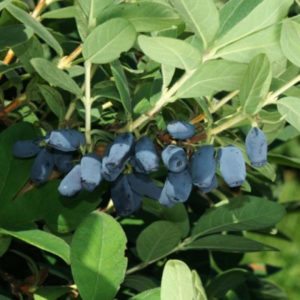
Leaves are bright green, whole-edged, elliptical in shape, up to 6 cm long, about 2.5 cm on cuttings.
The flowers are paired, white, with a fruity aroma. Located at the ends of the branches.
Berry-like fruits sit in pairs. Ripe fruits have an elongated oval shape, a length of about 12 mm and a bright blue color with a waxy coating. The mass of the berry is up to 3 g. The pulp is juicy, purple-red, sweet, with a slight sourness and strawberry aroma. Astringency is almost not felt. The berry tastes like blueberries.
Application features
Honeysuckle Avacha is a garden variety with edible fruits. The berries are dense, retain their shape well after heat treatment, give a lot of juice. The purpose of the fruit is universal. They are consumed fresh, stewed fruit and jams, canned, frozen and dried.
Ripening period and yield
The variety is early, high-yielding. In the south, it ripens in early June, and in the northern regions 2 weeks later (at the end of June). Spreads unevenly - from the top of the bush to the bottom. Ripe Avachi berries, unlike other varieties, do not crumble. Productivity - up to 2.5 kg per bush. Fruiting from 3 years of age and reaches maximum productivity at the age of 5 years.
Cold and disease resistance
The variety is resistant to environmental conditions, diseases and pests. Frost resistance - up to -34 ° С. The bush tolerates prolonged drought well, but the juiciness of the fruits depends on watering.
Growing regions and climate requirements
Variety grow in Siberia, in the Urals, in the middle zone, northwestern and southern regions of Russia. Avacha is adapted to cold winters and hot summers up to + 30 ° С. Optimum conditions are + 20 ... + 25 ° С.
Advantages and disadvantages of the variety
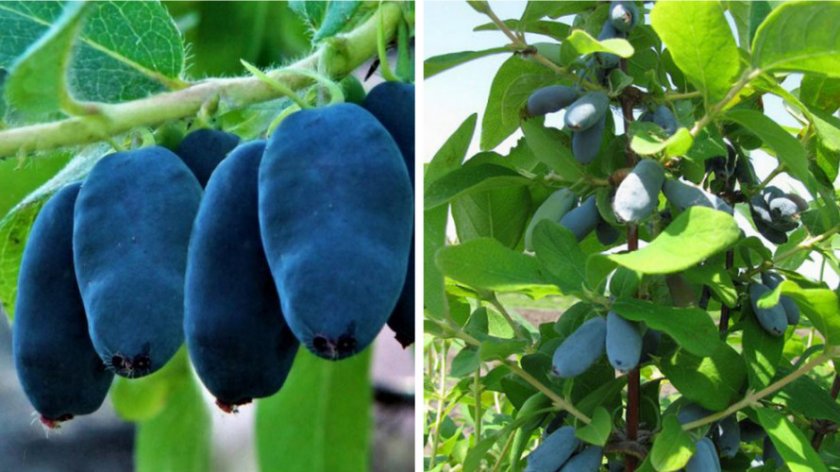
Benefits:
- high productivity;
- large-fruited;
- adaptability to low and high temperatures;
- early ripening;
- drought, disease and pest resistance;
- non-sprinkling of berries.
Disadvantages:
- pollinating varieties are required;
- uneven maturation;
- the lower shoots lie down.
Agrotechnics
Avachi bushes are planted in tandem with pollinators. They cannot be overfed with fertilizers; they are pruned every few years. Important points are to choose the right place for the culture, water abundantly during the ripening of the fruits and prevent the growth of weeds in the root zone.
Choosing a place in the garden
The size and flavor of the honeysuckle fruit depends on the lighting... The berries will be smaller in the sun, and sour in the shade. Therefore, the location for the culture is selected so that in the first half of the day the bushes are in the sun, and in the second - in partial shade.
Avacha is not planted in swampy and flooded areas or with surface groundwater. The roots quickly rot from dampness, and the plant dies.
A suitable location is a dry, level area free of drafts with shade in the afternoon (for example, along a fence).
Ground requirements
The soil is loose, moisture-permeable, enriched with humus. The plant bears fruit well on black earth and light loamy soil and worse on sandy. The acidity level is pH 5.5-6.5.
Preparing for landing
1-2 months before landing the area under the honeysuckle is dug to the depth of the bayonet, rotted manure (5 kg / m²) and wood ash (600 g / m²) are added.
Timing, scheme and landing rules
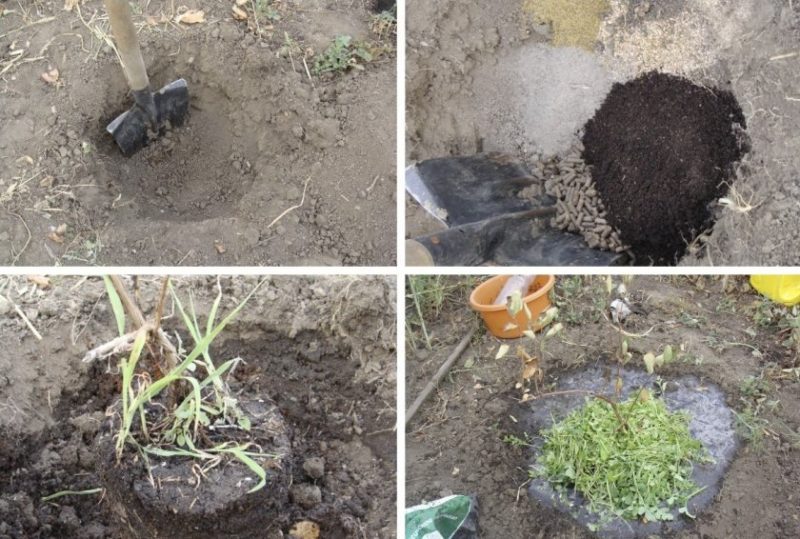
The bushes are planted in autumn - late September - early October, 1-1.5 months before the first frost.
The holes are dug at a distance of 2 m.The distance between the rows (if there are many plants) is 3 m.The depth of the planting hole is 40-45 cm, the diameter is 45-50 cm. 15 cm of drainage is poured into the holes, if the groundwater is 1.5 m from the surface.
The holes are filled with a mixture of soil and compost (2 kg of a mixture in a 1: 2 ratio). On chernozems, 1 tsp is added to each hole. superphosphate and potassium salt, on less fertile land - superphosphate and potassium salt, 100 g each.
The seedlings are placed in the holes, the roots are spread, watered (one bucket of water for each), sprinkled with earth. The root collar is deepened by 5-7 cm. The root zone is compacted, watered again (one bucket per bush) and mulched with 1 cm of peat or humus.
Reference. Bushes are not pruned after planting. This will slow down their growth.
Growing features
In spring, honeysuckle wakes up very early, and any intervention during the active growing season affects the dynamics of development. Therefore, the bushes are planted, pruned and transplanted only in the fall.
The root system is wide and shallow. It is watered not under the root, but along the near-trunk circle, which is 50 cm wider than the diameter of the crown. It is better to do this in the evening with water heated in the sun. During the period of flowering, formation and pouring of fruits, the ground is not allowed to dry out completely, watered so that the soil retains moderate moisture. After harvesting, watering is reduced to 1 time in 2 weeks. The rate of water is 10 liters per 1 bush.
Attention! From a lack of moisture, the berries will be small and tart in taste.
After each watering, the near-stem zone is loosened to a depth of 5-7 cm and weeds are removed. In spring and autumn, the bushes are spud.
Honeysuckle is fed once every 2-3 years. 5-7 kg of organic fertilizers are applied under each bush. Annually, the root zone is mulched with grass or humus. Other additional feeding is not required, otherwise the plants will grow, and the yield will noticeably decrease.
The first 5 years Avacha is not cut off. Only lodged and dried lower branches are removed. After 5 years, the center of the bush is thinned out - all shoots are cut out from the middle and the old skeletal branches are removed. On long shoots, the tops are cut off to 3 buds. In a properly formed bush, 10-15 strong branches of different ages are left. The next cardinal pruning will be needed after 3-4 years.
Pollinators
Avacha is a partially self-fertile variety. The bush forms 20-35% of the fruits of the total number of flowers. To increase the yield by 50-70%, other pollinating varieties with the same flowering period are planted nearby. The following varieties of garden honeysuckle are suitable for Avachi:
- Kamchadalka;
- Cinderella;
- Blue spindle;
- Azure;
- Blue bird;
- Malvina;
- Tomichka.
Disease and pest control
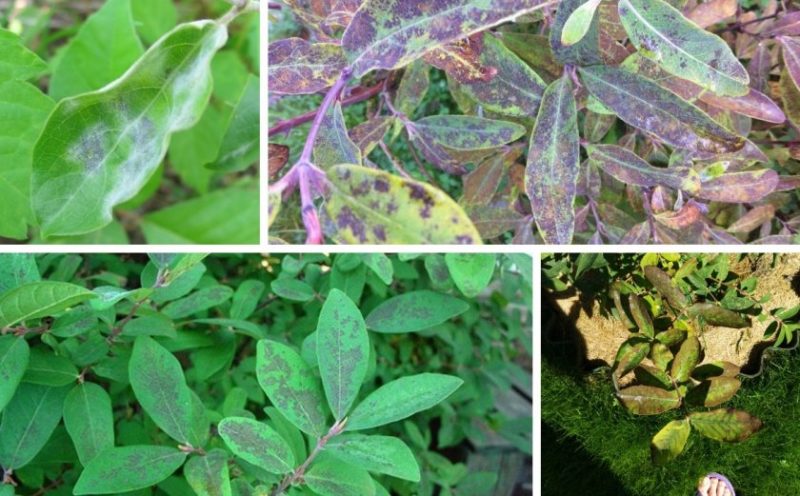
Honeysuckle practically does not get sick. The risk only exists under very unfavorable crop conditions:
- swampy or weedy area;
- critical heat and prolonged drought;
- massive infection of the garden.
Occasionally, there are aphids and honeysuckle infestations.Plants are treated with insecticides ("Tanrek", "Iskra", "Aktellik") and biological products ("Inta-Vir", "Jaguar", "Fitoverm") 20 days before flowering and again after harvest.
If insects appear during the ripening period of the fruit, use folk remedies:
- soap solution - 200 g of household or 100 g of tar soap per 10 liters of water;
- solution of wood ash or tobacco dust - 1 tbsp. powder per 10 liters of water;
- water with the addition of a few drops of essential oils of lemon, calendula or mint.
These funds will get rid of aphids and goldsmiths in 2-3 weeks. Spray every 3 days.
Powdery mildew infects bushes from other plants during sprinkling. After harvesting, they are treated with the preparations "Tiovit Jet", "Agrolekar", and during the ripening of the fruits - with solutions of wood ash and soda.
Preparing for winter
The variety is winter-hardy, so it is not specially insulated for the winter. But branches can break under the weight of snow or strong winds. They are harmed by rodents, and the fruit buds attract birds.
In autumn, the branches are collected in a bunch and tied at the top. The bush is wrapped in breathable material, carefully bent to the ground, sprinkled with soil a little and covered with spruce branches. In the spring, when the snow melts, the protection is removed.
Reproduction
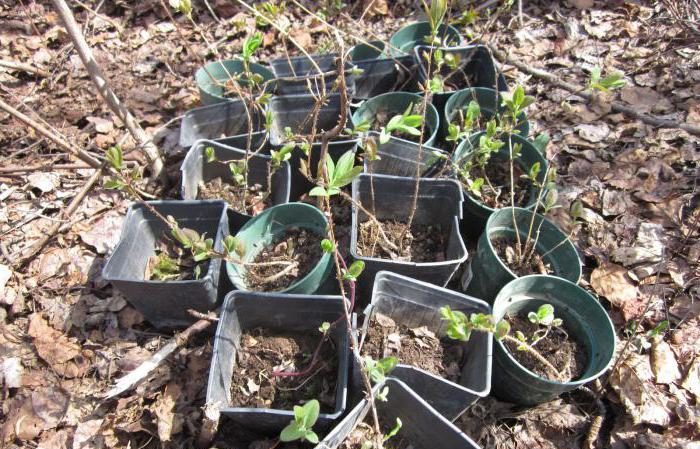
Honeysuckle has 4 breeding methods:
- cuttings;
- layering;
- dividing the bush;
- seeds.
Only strong, healthy plants are chosen for reproduction. Rooted shoots are always grown and planted in a permanent place at the age of 2-3 years.
Cuttings
Instructions:
- At the time of picking berries, a one-year growth is removed from the top of the bush. Shoots up to 10-12 cm long are chosen and pinched off at the attachment point with an adult branch.
- On the cutting, all the lower leaves are cut off, 3-4 apical leaves are left, which are cut off by half.
- Shoots are kept in a solution of "Heteroauxin" (root growth stimulant) for 12-16 hours.
- Rooted in a wet mixture of peat and sand (1: 3) at an angle of 45 °.
- The pots are placed in the garden in such a place so that after lunch the plantings are in the shade. Cover with a foil and maintain a constant moisture content of the substrate for a month. The greenhouse is aired daily.
- After a month, the roots will appear, and the film is removed. For the winter, planting is spud and insulated. They are planted in a permanent place after 1-2 years.
All sections are disinfected with wood ash, a weak solution of potassium permanganate or brilliant green.
By dividing the bush
For this, adult bushes at the age of 4-5 years are suitable, which have at least 6-9 skeletal branches. After leaf fall, the bush is dug up and divided into parts so that 3 stems remain in each. Plots are planted in separate holes, like ordinary seedlings.
Layers
This is done in early spring, before the buds swell. Several lower annual shoots are pressed to the ground and secured with staples. To stimulate root growth, the bark is incised where it contacts the ground. Layers are sprinkled with soil up to 5 cm, watered and hilled once a week. Roots will appear by autumn. The next spring, the layers are separated from the bush and planted in a permanent place.
Seeds
Large, ripe berries are kneaded in a bowl of water. The pulp and water are drained, and the seeds are disinfected for 2 hours in a 1% solution of potassium permanganate and dried in the shade. Sow in summer, spring (in April) or before winter - 2-3 weeks before the first frost. The seeds are buried 1 cm in 10 cm increments, watered and covered with foil. From the moment of germination, it is removed. In autumn sowing, the land is mulched with dry humus. The first shoots will appear in the spring.
Growing difficulties

Possible problems:
- Honeysuckle does not grow. In the first year after planting, the bush grows a root, and from the second, new shoots appear. If the plant looks stunted even after a year, it means that the wrong place has been chosen (a lot of sun or constant shade). In this case, the honeysuckle is transplanted.
- Few fruits... The honeysuckle has faded, but there are no or very few berries. This happens when only one bush is planted. The plant requires pollinating varieties. If there are a lot of bushes, but few berries, most likely, they are pecked by birds.To preserve the harvest, the bushes are protected with nets.
- Branches dry after wintering... The problem has several reasons: a lack of watering in the fall, an oversupply of fertilizer, or damage to the roots due to deep loosening of the root circle. If there is little rain in the fall, before wintering, the bushes are water-charged (a bucket of water for each plant). In other cases, mistakes in agricultural technology are corrected.
Harvesting
The fruits ripen quickly, but not at the same time - from the top of the bush to the lower branches. They are harvested every 3 days in the biological ripeness phase.
Fresh berries are stored for about 2 days, chilled immediately after harvest - up to 1 week.
Reviews of experienced gardeners
Most gardeners consider Avacha a reliable variety without an autumn awakening.
Svetlana, Samara: “I planted Avacha, Cinderella and Azure. For a year and a half, not a single escape, and then they began to grow sharply. Avachi's fruits are larger and less bitter than others. The most important thing to care for is to water well while it blooms and sets the fruit. Better to plant 3-5 bushes. "
Sergey P., Voronezh region: “I have different varieties. Honeysuckle grows slowly for the first 3-4 years, and then in 1-2 years it grows up to 1.5 m. The branches are fragile, I recommend planting so that you can freely approach the bush from all sides. I took Avacha because the berries do not crumble and the taste is very delicate, not harsh, not bitter. There are no diseases, but aphids often appear. I spray it with a solution of soda ash once a week (2 tablespoons per 1 liter of water and 2 tablespoons of garden soap). "
Conclusion
Avacha is grown throughout Russia. The variety is large in size edible fruit, which do not crumble after ripening. They are appreciated for their dessert taste and persistent strawberry aroma. The plant tolerates cold and drought, practically does not get sick. The culture is partially self-fertile, so Avachi bushes are planted next to pollinating varieties.